✓ Accommodations✓ Flights✓ Rental Cars
Located in southern Japan, Kagoshima Prefecture is a vibrant cultural destination known for its unique and diverse festivals throughout the year. These events offer visitors an authentic glimpse into local traditions, history, and community life that has been preserved for centuries.
As you plan your trip to this fascinating region, you’ll discover that many of these festivals have been designated as Important Intangible Folk Cultural Properties, showcasing their historical and cultural value. By experiencing these events, you’ll gain a deeper understanding of Kagoshima’s culture beyond typical tourist attractions.
This guide will take you through the most significant festivals, providing you with practical information for planning your visit, including transportation tips and cultural etiquette, ensuring a memorable experience.
Discovering Kagoshima’s Rich Festival Culture
As you explore Kagoshima Prefecture, you’ll discover a rich tapestry of festivals that reflect the region’s unique cultural identity. These events are deeply rooted in the region’s history and showcase the local traditions that have been passed down through generations.
The festivals in Kagoshima are not just entertaining spectacles; they are a way to experience the authentic culture of Southern Kyushu. From agricultural rituals to community bonding events, each festival has its own unique significance.
The Cultural Significance of Festivals in Southern Kyushu
Festivals in Kagoshima Prefecture are a reflection of the region’s cultural heritage, shaped by its history and geography. Located in Southern Kyushu, Kagoshima’s festivals have been influenced by its position as a historical gateway to international trade, incorporating elements from various cultures.
Winter Festivals in Kagoshima Prefecture
As the winter season sets in, Kagoshima Prefecture comes alive with unique and fascinating festivals. One of the most notable events is the Doya-doya-saa Onibitaki, a traditional demon expulsion bonfire ritual.
Doya-doya-saa Onibitaki: The Demon Expulsion Bonfire
The Doya-doya-saa Onibitaki festival is held annually on January 7 in the Shimohama area of Uchinoura. It’s a significant folk tradition where a bonfire is made using New Year’s decorations to symbolically ward off evil and misfortune for the coming year. The ceremony features a tall bamboo pole decorated with a folding fan bearing the hinomaru, a five-colored cloth, and origami.
The festival involves local children holding twelve ropes representing the signs of the Chinese zodiac, with each rope held by children born in the same month, showcasing a unique blend of tradition and community participation.
Winter Festivals in Kagoshima Prefecture
January in Kagoshima Prefecture brings an exciting opportunity for runners with the Ibusuki Nanohana Marathon, Japan’s first full marathon of the year. This event is a significant highlight in the national running calendar, attracting both professional athletes and amateur runners.
Ibusuki Nanohana Marathon: Japan’s First Full Marathon of the Year

The Ibusuki Nanohana Marathon is renowned for its scenic route that takes runners through Ibusuki’s picturesque winter landscape. The course is particularly notable for the vibrant fields of nanohana (rapeseed) flowers that bloom in January, creating a breathtaking scenery. Runners can enjoy views of Mount Kaimon, often referred to as the “Fuji of Satsuma,” adding a cultural dimension to the athletic challenge.
The mild winter climate of southern Kagoshima Prefecture makes it an ideal location for a January marathon, unlike much of Japan which experiences colder weather during this time. This unique aspect, combined with the event’s scenic beauty, attracts participants from across the country and internationally, fostering a festive atmosphere.
After completing the marathon, participants can unwind and rejuvenate with Ibusuki’s famous natural sand baths and hot springs, offering a unique recovery experience. The event is not just about the athletic challenge but also about immersing in the local culture and enjoying the natural beauty of Kagoshima Prefecture. Visitors can capture memorable photos during the event, making it a truly unforgettable experience.
The Ibusuki Nanohana Marathon is a testament to Kagoshima Prefecture’s ability to host world-class events that combine sport, culture, and natural beauty, making it a must-visit destination for runners and travelers alike.
Spring Cherry Blossom Festivals
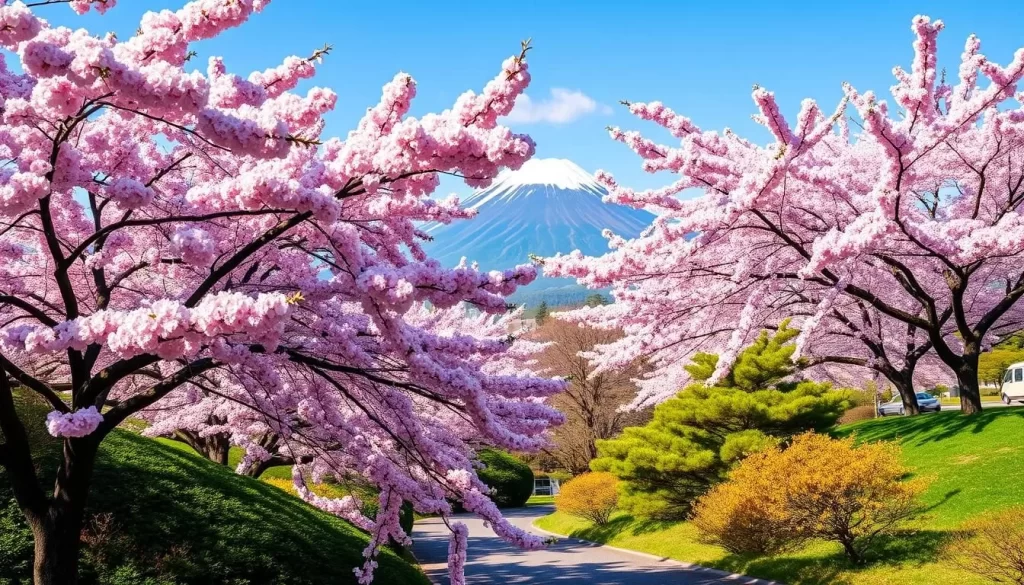
The arrival of spring in Kagoshima marks the beginning of the cherry blossom season, a time when the prefecture’s landscapes are painted with delicate pink hues. One of the premier locations to witness this spectacle is Yoshino Park, renowned for its stunning cherry blossom display.
Yoshino Park Cherry Blossom Festival
Yoshino Park is one of Kagoshima’s top cherry blossom viewing locations, boasting over 800 cherry trees that create a breathtaking canopy of pink during spring. The park’s unique vantage point offers an impressive view of Sakurajima volcano across Kinko Bay, making it a photographer’s paradise.
During the bloom period, the park transforms into a vibrant festival site, complete with special illuminations that turn the park into a magical nighttime spectacle. Visitors can enjoy the blossoms during the day and experience the park’s enchanting ambiance at night.
The hanami (flower viewing) tradition is deeply rooted in Japanese culture, and Kagoshima residents eagerly embrace this custom with picnics and gatherings under the blossoms. The festival period is typically from late March to early April, although the exact dates vary annually based on weather conditions.
To enhance your cherry blossom experience, the park offers various amenities during the festival, including food vendors, cultural performances, and special events. Whether you’re looking to enjoy a serene picnic or participate in the lively festivities, Yoshino Park is a must-visit destination.
Spring Cherry Blossom Festivals
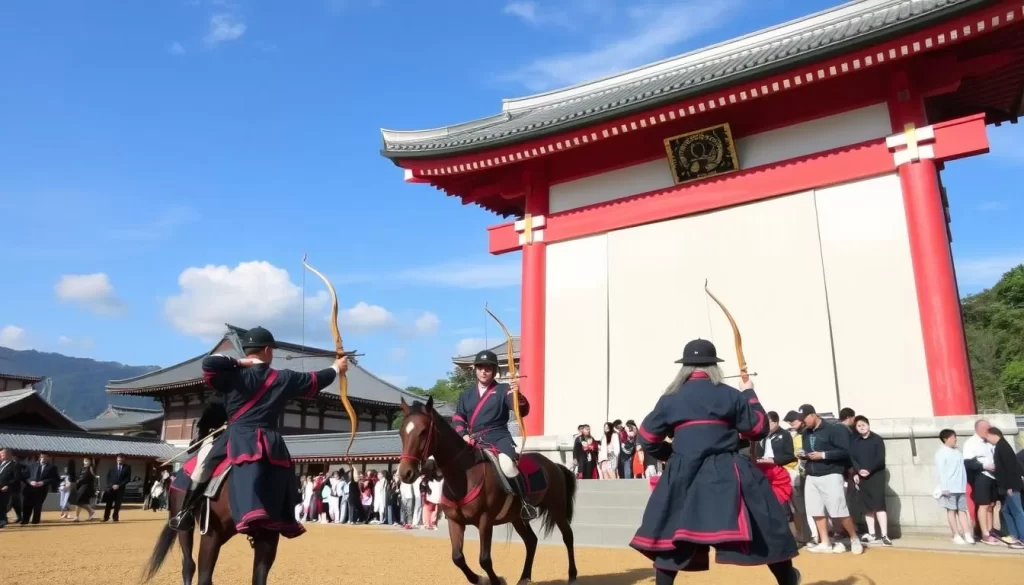
The tradition of hanami in Kagoshima is a cherished one, with the prefecture’s volcanic soil and climate creating a distinct cherry blossom viewing experience. You can immerse yourself in the local culture by participating in the festivities.
Hanami Traditions in Kagoshima
In Kagoshima City and its surrounding areas, hanami is celebrated with great fervor, showcasing the region’s rich cultural heritage. Local families and groups typically gather for hanami, enjoying special foods and drinks that are traditional to Kagoshima hanami gatherings, such as sakura-mochi and sweet sake.
The time of cherry blossom blooming in Kagoshima can vary, influenced by the prefecture’s unique climate. Generally, the blossoms bloom earlier in Kagoshima compared to other parts of Japan, making it an attractive destination for early spring travelers.
Beyond the famous parks, there are numerous lesser-known but beautiful cherry blossom viewing spots throughout Kagoshima Prefecture. Visitors can explore these hidden gems to experience the full beauty of hanami in Kagoshima.
Modern hanami practices in Kagoshima blend traditional elements with contemporary celebrations. You can witness traditional dances, food stalls, and modern festivities that add a unique twist to the traditional hanami experience.
The historical significance of cherry blossoms in Kagoshima’s cultural identity is profound, with references in local poetry, art, and folklore. The cherry blossoms symbolize the fleeting nature of life and are deeply ingrained in the local culture.
Shibushi Buddha Festival: A Cultural Treasure
One of Kagoshima’s most treasured festivals is the Shibushi Buddha Festival, a celebration that has been a cornerstone of the region’s cultural heritage for centuries.
History and Significance of the Buddha Festival
The Shibushi Buddha Festival is one of the three largest festivals in Kagoshima Prefecture, boasting a rich history that dates back to the Edo Period (1603-1868). This significant event celebrates the birthday of Siddhartha Gautama, traditionally believed to be April 8, although it is now observed on April 29, coinciding with Greenery Day, a national holiday.
The festival is primarily held at Homan-ji, a revered temple established in the 8th century and dedicated to the worship of Kannon, the Goddess of Mercy. The date “shigatsu yohka” (April 8) in standard Japanese is pronounced “shigajjoka” in the local Kagoshima dialect, highlighting the unique linguistic connection to the local culture.
The Buddha Festival holds profound religious significance, not only as a Buddhist celebration but also as a prayer site for easy childbirth. This dual significance has influenced some of the festival’s unique traditions, making it a cherished event for the community.
Over the years, the Shibushi Buddha Festival has evolved while maintaining its core cultural significance. It continues to be a grand celebration, reflecting the region’s deep-rooted cultural heritage and its importance in the lives of the people of Kagoshima.
Shibushi Buddha Festival: A Cultural Treasure
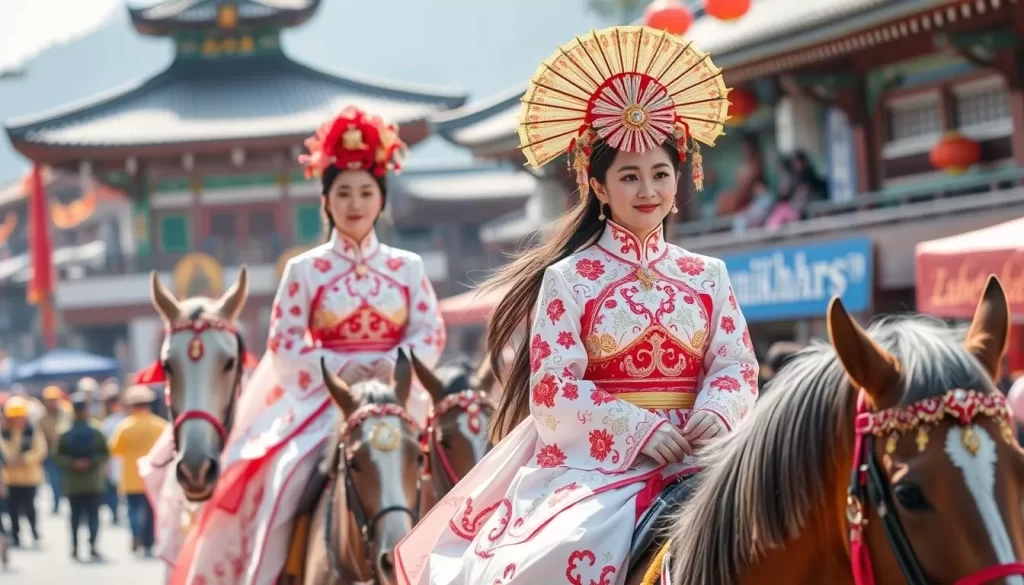
At the heart of the Shibushi Buddha Festival lies the enchanting Shan-Shan Horse Parade, a tradition steeped in history and culture. This highlight of the festival is a must-see event, drawing visitors from all over to witness its splendor.
The Spectacle of the Shan-Shan Horse Parade
The Shan-Shan Horse Parade is the most distinctive feature of the Shibushi Buddha Festival, known throughout the region for its unique blend of tradition and festivity. The parade features women dressed as brides in beautiful kimono being led on horseback toward Homan-ji temple, creating a visually stunning procession.
The name “shan-shan” refers to the melodic ringing sound of bells attached to the horses’ harnesses, which creates a distinctive soundtrack for the Buddha Festival. This auditory element adds to the overall ambiance, making the event even more memorable for attendees.
The parade is closely linked to Homan-ji temple’s reputation for offering blessings related to easy childbirth. As such, brides are prominently featured, riding on horses decorated with bells. The procession also includes other elements, such as small children carried in swing-like baskets and warriors marching through town, adding to the festival’s visual richness.
Following the picturesque Shan-Shan Horse Parade are lively performances of the Hanya-bushi song and dance. These performances encourage visitor participation and create an energetic atmosphere, making the parade an unforgettable experience.
Traditional Horseback Archery: Shijukusho Shrine Yabusame
Yabusame, a revered form of horseback archery, is a testament to Kagoshima’s deep-rooted traditions and history. This ancient martial tradition is preserved through rigorous training and dedication, reflecting the techniques and spirit of the samurai.
The Ancient Art of Yabusame in Kagoshima
Yabusame is more than just a display of archery skills; it is a sacred ritual that embodies the spiritual and cultural heritage of the Osumi Peninsula. At Shijukusho Shrine in Kimotsuki, the Yumiuke no Gi, or Accepting of the Bow Ritual, is a significant ceremony where archers are appointed as divine messengers.
The archers don traditional attire, including the kariginu (hunting garment) and ayaigasa (conical hat), which are reminiscent of historical samurai traditions. As they ride down the track on their sacred horses, they shoot kaburaya (whistling arrows), creating a spectacle that is both thrilling and deeply spiritual.
The spiritual significance of Yabusame lies in its role as a ritual offering to the gods, believed to bring good fortune to the community. This tradition has been preserved through generations of dedicated practitioners who train rigorously to maintain the precise techniques required.
While Yabusame is practiced in other parts of Japan, the Kagoshima version has distinct regional characteristics that reflect local history and traditions. The people of Kagoshima take great pride in this heritage, and it is a significant part of their cultural identity.
Traditional Horseback Archery: Shijukusho Shrine Yabusame
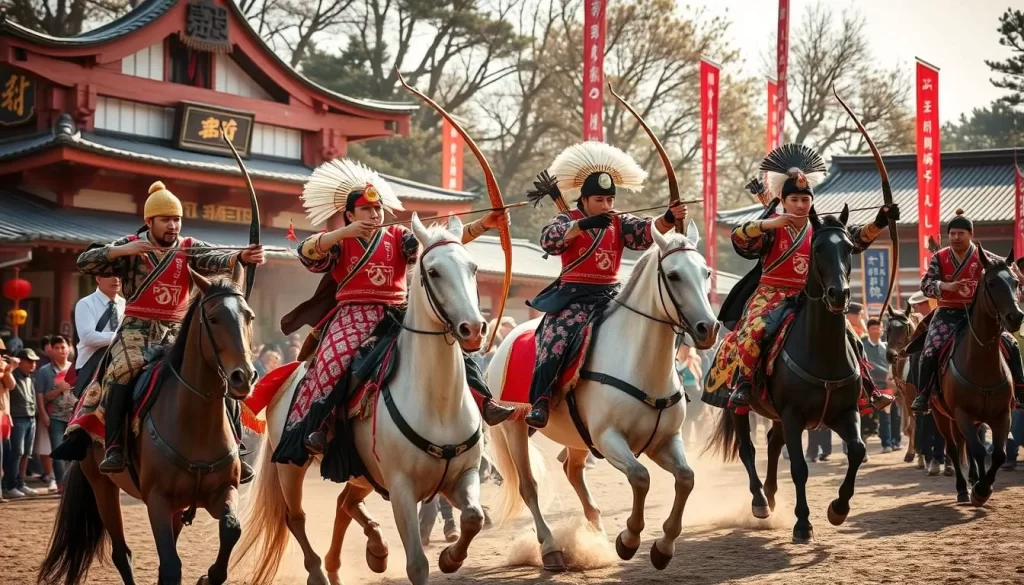
The Yabusame festival at Shijukusho Shrine is a unique event that showcases traditional Japanese horseback archery. This ancient ritual is not only a thrilling spectacle but also a significant cultural experience that attracts visitors from all over the world.
What to Expect at the Yabusame Festival
The Yabusame festival is a dramatic spectacle where skilled archers on galloping horses attempt to hit targets along a roughly 330-meter track. The festival begins with the hikite, or horse handler, calling out to the horse, which then rushes forward, carrying the archer through the course three times, firing a total of nine arrows at wooden targets.
Each archer must maintain control of their horse at full gallop while firing arrows, making this a challenging and impressive display of skill and bravery. The format of the competition is steeped in tradition, with the archers riding the course three times and firing nine arrows in total.
The significance of successful shots is deeply rooted in tradition; it is believed that the more arrows that hit their targets, the better the next year’s harvest will be for the community. This belief adds a layer of cultural depth to the event, making it not just an entertaining spectacle but also a meaningful ritual.
The role of the hikite is crucial, as they are responsible for calling the horse forward at the beginning of each run, adding to the ceremonial nature of the festival. The atmosphere surrounding the main archery event is lively, with food stalls, other performances, and spectators cheering on the archers during particularly impressive shots.
For visitors, the Yabusame festival offers a unique cultural experience. To make the most of your visit, consider standing near the targets for dramatic photographs, and follow the action throughout the day to fully appreciate the skill and tradition on display.
Summer Dance Festivals
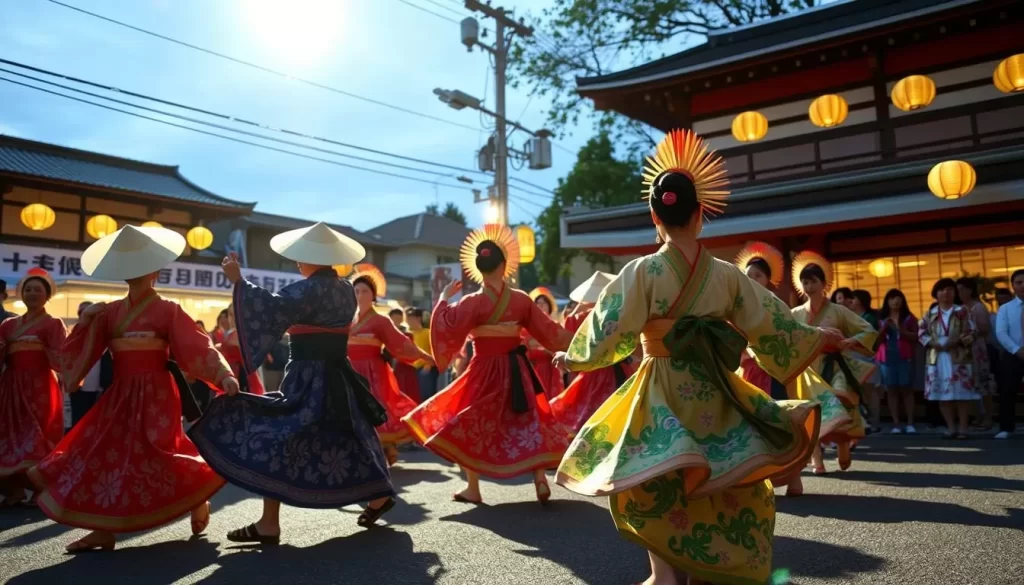
One of the most captivating aspects of Kagoshima’s summer is its traditional dance festivals, steeped in history and culture. As you experience the city’s vibrant summer, you’ll have the opportunity to witness the beautiful Tanabata Odori Dance, a tradition that has been cherished for over 300 years.
Tanabata Odori Dance: 300 Years of Tradition
The Tanabata Odori Dance is a testament to Kagoshima’s rich cultural heritage, with a history spanning over 300 years. This traditional dance is deeply connected to the Tanabata star festival celebrated across Japan, yet it boasts distinctive elements that make it uniquely Kagoshima.
Dancers adorned in traditional costumes perform intricate choreography accompanied by preserved musical tunes, narrating the tale of the star-crossed lovers Orihime and Hikoboshi. This summer tradition is not only a form of entertainment but also a living museum of Kagoshima’s cultural legacy, where people of all ages come together to participate and pass down the dance and songs through generations.
As you watch the Tanabata Odori Dance, you’ll be witnessing a tradition that has survived modernization, a true reflection of Kagoshima’s community spirit and cultural richness. The dance festival is a highlight of Kagoshima’s summer calendar, offering a unique insight into the city’s history and cultural identity through the beautiful dance performances.
Summer Dance Festivals
The warmth of Kagoshima’s summer is matched by the fervor of its dance festivals, deeply rooted in local traditions. One of the most significant summer festivals is the Hachigatsu-odori, or August Dance, a celebration that embodies the spirit of the community.
The August Dance Tradition
The Hachigatsu-odori is a dance tradition with deep agricultural roots, possibly dating back to 1671 when it was performed to celebrate the completion of the Koyama irrigation channel. Various theories surround its origins, including celebrations for rice paddy reclamations, completion of irrigation channels, harvest festivals, memorials for the dead, and prayers for peace.
On the day of the festival, the Kane-odori (Gong Dance) is performed before the village’s water god, followed by a dance at the irrigation channel. In the evening, the Hachigatsu-odori is performed by the village’s yagura (bandstand tower), highlighting the Shinto religious elements of the dance as both a prayer and thanksgiving to divine spirits and ancestors.
The Hachigatsu-odori is characterized by its distinctive movements, costumes, and music, with regional variations found throughout Kagoshima Prefecture. This dance continues to connect modern participants to their agricultural heritage and reinforces community bonds through shared cultural expression.
By participating in the Hachigatsu-odori, you become part of a long-standing tradition that celebrates the community’s history and agricultural roots. The festival is a testament to the enduring spirit of Kagoshima’s people.
Ohara Matsuri: Kagoshima’s Lively Summer Festival
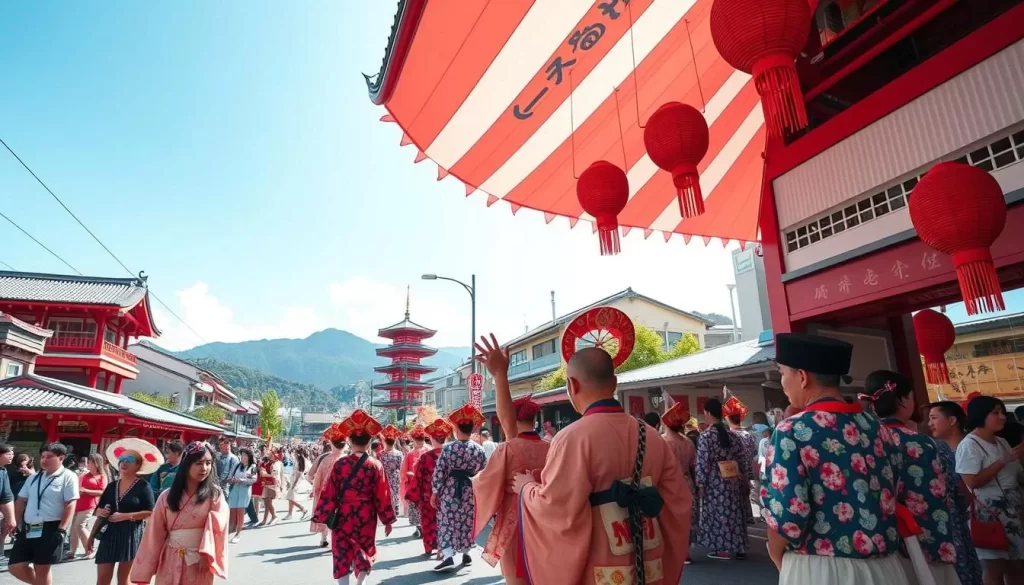
As summer peaks in Kagoshima City, the Ohara Matsuri festival brings the community together in a celebration of dance, music, and tradition. This vibrant event is a hallmark of Kagoshima City’s summer calendar, transforming the city’s streets into a kaleidoscope of color and energy.
The Vibrant Parade and Street Performances
The centerpiece of Ohara Matsuri is its grand parade, featuring thousands of dancers moving in synchronized formations down the main streets of Kagoshima City. The distinctive Ohara dance style combines traditional movements with contemporary elements, making it accessible even for visitors to join in. Participants wear matching happi coats in vibrant colors, along with traditional headbands, and carry fans or other props as part of their choreography, creating a visually stunning spectacle.
The festival atmosphere is further enhanced by the presence of food stalls, street performances, and special events that transform the city center during the festival period. You can indulge in local cuisine, watch impromptu performances, and soak up the lively ambiance that pervades every corner of the city.
Ohara Matsuri is not just a festival; it’s a point of pride for Kagoshima City residents. It has become an important tourism draw during the summer season, attracting visitors from all over who come to experience the unique cultural heritage of the region. As you join in the festivities, you’ll be immersed in the local culture and community spirit that defines Ohara Matsuri.
So what are you waiting for? Come join in the Ohara Matsuri and be a part of Kagoshima City’s most vibrant summer celebration!
Ohara Matsuri: Kagoshima’s Lively Summer Festival
Participating in Ohara Matsuri offers a unique chance to engage with the local community, learn traditional dances, and experience the warmth of Kagoshima’s people. This vibrant summer festival is not just a spectacle to watch; it’s an invitation to join in and become a part of the celebration.
Getting Involved in the Festival
Visitors are encouraged to actively participate in Ohara Matsuri by joining one of the many dance groups that welcome foreign participants. To get started, you can register at the local community center or through the official festival website. The typical cost for costume rental is around ¥5,000, which is a small price to pay for the unforgettable experience you’ll have.
Newcomers are offered basic practice sessions to learn the traditional dance steps, which are easy to follow and require no prior dance experience. As you dance alongside the local people, you’ll feel a strong sense of community and create meaningful cultural exchange through shared experience.
The Ohara dance is characterized by its energetic movements and simple steps, making it accessible to everyone. You can quickly pick up the basic steps and be ready to dance in the parade in no time. Many previous foreign visitors have found participating in Ohara Matsuri to be a highlight of their Japan experience, and you can be sure to create lifelong memories.
Tips for Spectators
If you prefer to watch rather than participate, there are plenty of great viewing spots along the parade route. The best spots are usually near the city center, where you can see the most elaborate performances. Don’t forget your camera, as the vibrant colors and energetic atmosphere make for fantastic photography opportunities.
Whether you choose to participate or watch, Ohara Matsuri is an event that embodies the spirit of Kagoshima. It’s a time when the community comes together, and visitors are warmly welcomed to join in the festivities. So, be sure to add Ohara Matsuri to your itinerary when visiting Kagoshima in the summer.
Spectacular Summer Fireworks Displays
One of the most anticipated summer events in Kagoshima is the Kinko Bay Summer Night Fireworks Display, a true spectacle not to be missed. This grand event transforms the night sky into a kaleidoscope of colors, captivating the hearts of all who witness it.
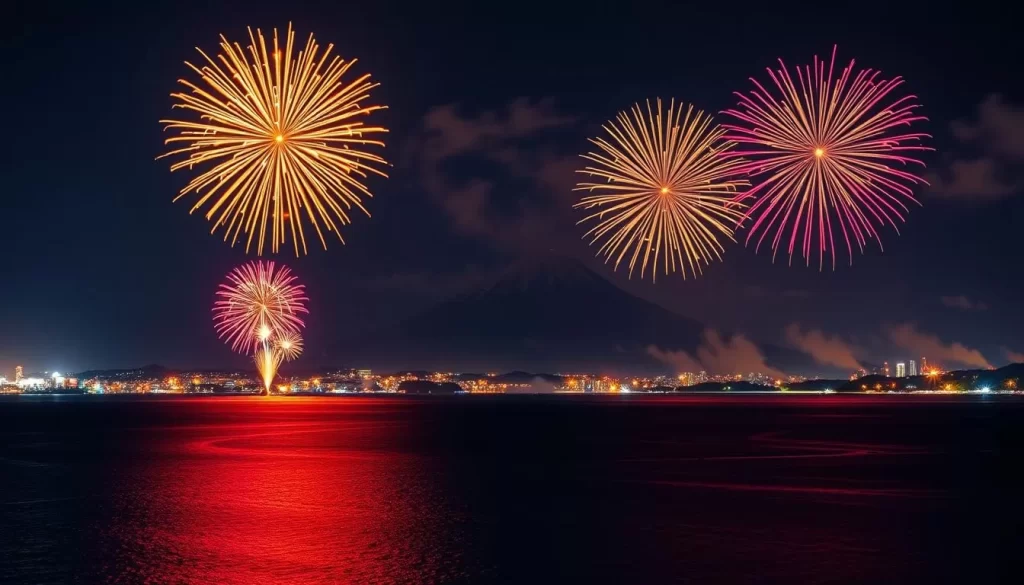
Kagoshima Kinko Bay Summer Night Fireworks Display
The Kagoshima Kinko Bay Summer Night Fireworks Display stands out as one of the largest pyrotechnic events in southern Japan, boasting an astonishing 150,000 fireworks. The unique setting of this display, with the illuminations reflecting off the waters of Kinko Bay and the silhouette of Sakurajima volcano creating a dramatic backdrop, makes it a truly unforgettable experience.
The fireworks featured in this display range from traditional Japanese designs to innovative modern displays choreographed to music, ensuring a mesmerizing experience for all attendees. Locals and visitors alike enjoy this summer spectacle, with many families setting up picnic spots hours in advance or viewing from chartered boats in the bay.
For those planning to attend, some of the best viewing locations around Kinko Bay include Dolphin Port, Shiroyama Observatory, and waterfront parks. Each of these spots offers a unique perspective on the display, ensuring that every viewer can enjoy the fireworks to their fullest potential.
Fireworks displays, or “hanabi,” hold significant cultural value in Japanese summer traditions, representing a highlight of Kagoshima’s festival calendar. The Kinko Bay event is a testament to the region’s rich cultural heritage and its ability to bring people together in celebration.
Spectacular Summer Fireworks Displays
Experience the magic of summer in Kagoshima at the Sendaigawa River Fireworks Display, where tradition meets spectacle. This event is a quintessential summer experience, offering a unique blend of cultural heritage and modern entertainment.
A More Intimate Fireworks Experience
The Sendaigawa River Fireworks Display is a more intimate but equally impressive alternative to the larger Kinko Bay event, offering a different atmosphere and setting that attracts both locals and visitors. As you watch the fireworks along the Sendaigawa River, dressed in a traditional yukata (summer kimono), you’ll be immersed in a quintessential Japanese summer experience.
The river setting of the fireworks display creates a unique visual effect, with the water reflecting the vibrant colors and patterns of the fireworks, effectively doubling their visual impact. This setting not only enhances the beauty of the display but also provides a serene backdrop that complements the energetic atmosphere of the festival.
The Sendaigawa River Fireworks Display is more than just a fireworks show; it’s a complete evening experience. The event is accompanied by a lively festival atmosphere, complete with food stalls offering traditional Japanese cuisine, games, and cultural performances that add to the excitement and enjoyment of the evening.
To make the most of your visit, it’s advisable to arrive early to secure a good viewing spot along the river or in nearby parks. These locations offer optimal views of the fireworks display, ensuring that you have a memorable experience.
For those looking to fully immerse themselves in the traditional Japanese experience, there are yukata rental options available for visitors. Wearing a yukata is a great way to participate fully in the spirit of the festival, and it adds to the overall ambiance of the event.
When planning your visit, consider the time of the fireworks display and plan accordingly to avoid the crowds and make the most of your evening at the Sendaigawa River Fireworks Display.
Terukuni Shrine Rokugatsudo Lantern Festival
Kagoshima Prefecture is home to the breathtaking Terukuni Shrine Rokugatsudo Lantern Festival, a true highlight of the region’s festival calendar. This magnificent event is the largest of its kind in Kagoshima Prefecture, creating a magical atmosphere through thousands of paper lanterns.
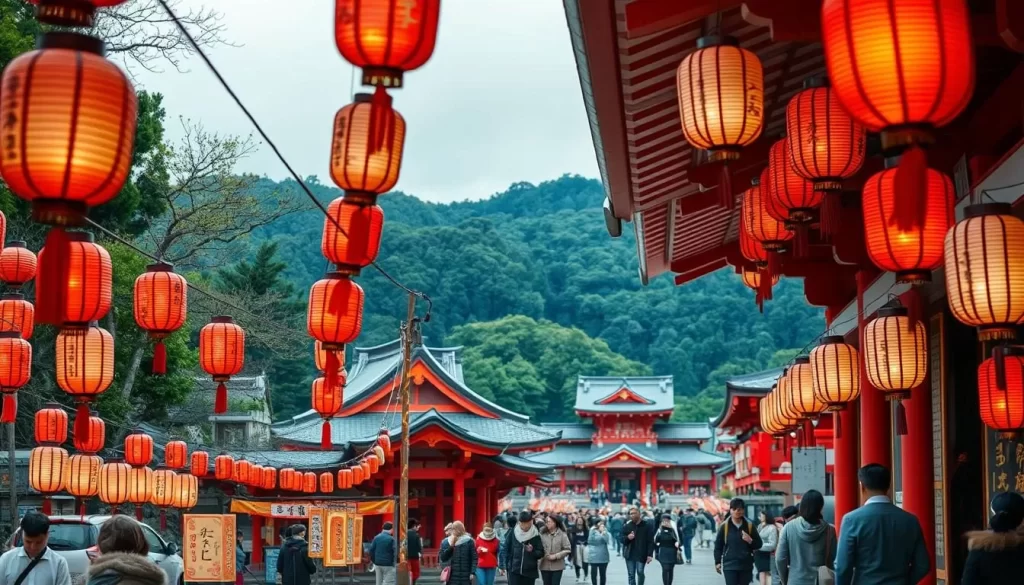
The Illuminated Night Procession
The centerpiece of the Terukuni Shrine Rokugatsudo Lantern Festival is the illuminated night procession, where participants carry glowing lanterns through the darkened streets toward Terukuni Shrine. This procession is not only a visual spectacle but also holds deep historical and religious significance.
The Rokugatsudo observance, which the festival is based on, has its roots in the lunar calendar. Over time, it has evolved into this spectacular visual celebration, blending tradition with modern festivity.
- The festival features various styles of lanterns, from simple hand-held versions to elaborate decorated structures, showcasing the craftsmanship involved in their creation.
- The soft lantern light illuminates the shrine grounds and procession route, creating an ethereal atmosphere that makes this a photographer’s dream event.
- The festival transforms the urban environment of Kagoshima City, creating a temporary landscape of light that connects modern participants to ancient traditions.
As you experience the Terukuni Shrine Rokugatsudo Lantern Festival, you’ll be immersed in a world of light and tradition. The festival is a testament to the rich cultural heritage of Kagoshima Prefecture, making it an unforgettable experience for all who attend.
Terukuni Shrine Rokugatsudo Lantern Festival
As you experience the Terukuni Shrine Rokugatsudo Lantern Festival, you’ll uncover the rich cultural tapestry of Kagoshima. This festival is not just a visual spectacle but a deep dive into the history and traditions of the region.
Cultural Significance of the Lantern Festival
The Rokugatsudo Lantern Festival holds profound cultural significance, serving as a connection to ancestor worship and Buddhist traditions in Kagoshima. The lanterns symbolically light the way for ancestral spirits during Obon season, a period when the living honor and connect with the deceased in Japanese spiritual tradition.
The festival at Terukuni Shrine is characterized by specific religious practices, including prayers, offerings, and rituals that accompany the lantern displays. These practices underscore the shrine’s role in maintaining and passing down cultural heritage.
| Cultural Aspect | Description | Significance |
|---|---|---|
| Lanterns | Symbolize guidance for ancestral spirits | Connects the living with the deceased |
| Ancestor Worship | Honoring ancestors during Obon season | Preserves traditional Japanese spiritual practices |
| Buddhist Traditions | Incorporates Buddhist rituals and beliefs | Reflects the blend of Shinto and Buddhist elements in Japanese culture |
The historical development of the festival is a fascinating narrative of evolution from a purely religious observance to a more elaborate community celebration. Over time, the festival has incorporated various elements, making it a vibrant representation of Kagoshima’s cultural identity.
One of the most heartwarming aspects of the Rokugatsudo Lantern Festival is its intergenerational appeal. Families participate together, passing down traditions of lantern-making and festival participation. This continuity ensures the preservation of cultural practices for future generations.
The festival represents a unique blend of Shinto and Buddhist elements, characteristic of much of Japanese religious practice. This syncretism is particularly evident in festival traditions, where different beliefs and practices coexist and enrich each other.
Sendai Great Tug-of-War: A Test of Strength
The Sendai Great Tug-of-War is an exhilarating experience that combines tradition, community, and a test of strength. This event is one of Japan’s largest and most physically impressive festival events, drawing thousands of participants.
The Massive Rope and Community Participation
The central attraction of the Sendai Great Tug-of-War is its massive rope, which is 365 meters long and weighs around 40 tons. The rope is made using traditional methods, involving the braiding of numerous smaller ropes together. This enormous rope is not just a symbol of the event; it’s a testament to the community’s collective effort.
The event is characterized by its strong community aspect, where entire neighborhoods, schools, and workplaces form teams to participate. This tug-of-war is a true test of collective strength, requiring coordination, teamwork, and determination.
The competition is typically divided into teams representing different sides of the city, often the east versus the west. The team that successfully pulls the rope a certain distance towards their side is declared the winner. If you’re interested in participating, you can join in with the local teams, and foreigners are typically welcome to join this community event.
To get the most out of your experience, be sure to arrive early to witness the preparatory rituals and enjoy the accompanying entertainment. The festive atmosphere is electric, with food stalls, performances, and celebrations that continue long after the main tug-of-war event.
For those looking for information on how to participate or simply to enjoy the event, local guides and festival organizers are usually available to provide assistance. You can expect a warm welcome as you join in the festivities, making it a memorable experience for people from all walks of life.
As you enjoy the Sendai Great Tug-of-War, you’ll be part of a significant event that showcases community spirit and traditional strength. Make sure to soak in the atmosphere and enjoy the camaraderie that defines this unique festival.
Sendai Great Tug-of-War: A Test of Strength
Deep-rooted in history, the Sendai Great Tug-of-War is more than just a competition; it’s a celebration of Kagoshima’s rich cultural heritage. This event, held annually, is a testament to the community’s strength and unity.
History and Traditions of the Tug-of-War
The Sendai Great Tug-of-War has its origins in an agricultural ritual aimed at ensuring good harvests. Historical records trace its history back several centuries, highlighting its evolution over the years while maintaining its core cultural significance.
The tug-of-war is not just a physical contest; it’s steeped in tradition and beliefs. The outcome is believed to predict the future, including harvests, fishing catches, and community fortune in the coming year. This belief underscores the event’s importance to the local community.
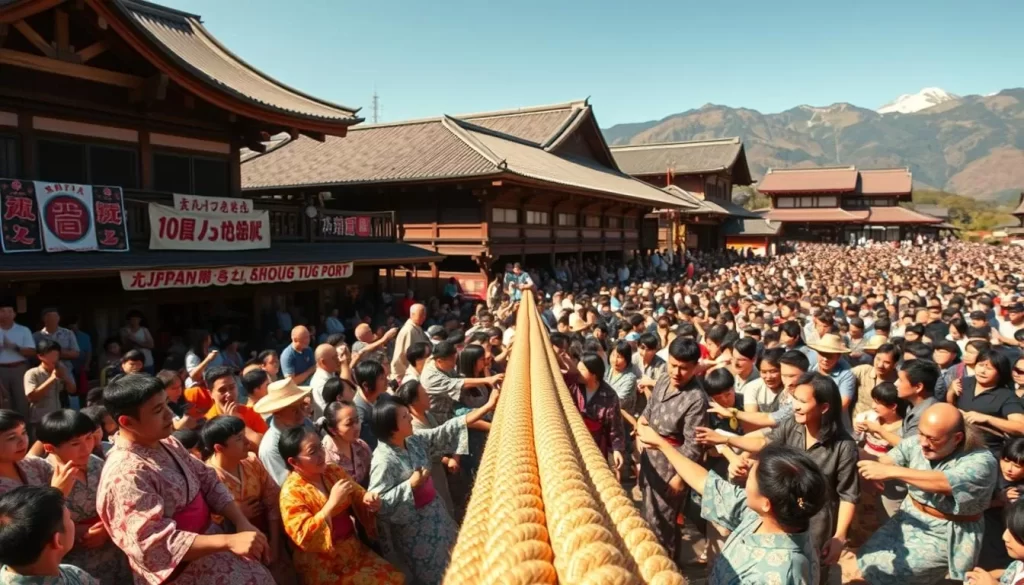
Some of the unique customs associated with this event include the beliefs surrounding the rope used in the tug-of-war. The rope is considered to have powers, and pieces of it are often sought after by participants as mementos or talismans.
The festival has shown remarkable resilience, surviving through challenging historical periods including wars and natural disasters. It has become a symbol of community resilience and solidarity.
While tug-of-war traditions can be found in other parts of Japan and Asia, the Sendai Great Tug-of-War has its distinctive characteristics. The event’s history, the significance of the rope, and the community’s involvement make it a unique cultural experience.
- The event originated as an agricultural ritual.
- It has evolved over hundreds of years, maintaining its cultural significance.
- The outcome is believed to predict future harvests and community fortune.
- The rope used is believed to have special powers.
- The festival is a symbol of community resilience.
By participating in or witnessing the Sendai Great Tug-of-War, you are experiencing a vital part of Kagoshima’s cultural identity. This event is a powerful reminder of the importance of community and tradition.
Unique Fire Festivals of Kagoshima
On the dramatic coastline of Cape Toi, a fiery spectacle awaits during the fourth Friday and Saturday of August. The Cape Toi Fire Festival is a highlight of Kagoshima’s festival calendar, drawing visitors from far and wide to witness its breathtaking display.
Cape Toi Fire Festival: A Dramatic Night Spectacle
The Cape Toi Fire Festival is steeped in tradition and legend. It reenacts the story of a monk named Eitokubo who bravely defeated a giant serpent terrorizing the local population by wielding fire. This ancient legend is brought to life through a dynamic fire dance that illuminates the night sky, creating an unforgettable experience.
The festival’s centerpiece is a 30-meter (98-foot) pine tree, symbolizing the serpent, topped with a pile of straw representing the serpent’s mouth. As the climax approaches, dancers, with a resounding call of “Tontokototte, Eitokubo” (“Eitokubo has killed the serpent at last”), fling their torches at the straw target. The torches arc through the darkness, flying towards the pillar, and when they hit the target, the entire structure erupts in a fierce blaze.
This dramatic display is set against the backdrop of the sea, with Cape Toi’s coastal location adding to the spectacle. The contrast between the dark waters and the bright flames creates a visually stunning effect, as if the festival itself is a celebration of the clash between fire and water.
The visual impact is heightened by the reflection of the fire in the waters off Cape Toi, creating a double spectacle that is both on land and in the sea. The culmination of the festival features fireworks that represent the serpent’s fiery blood, adding to the dramatic narrative of the event.
Visiting the Cape Toi Fire Festival is an experience that combines cultural heritage with a unique natural setting, making it a must-see event for anyone interested in Kagoshima’s rich festival culture.
Unique Fire Festivals of Kagoshima
Sogadon no Kasayaki is a remarkable fire festival that highlights Kagoshima’s pride in its ‘Goju education’ system. This traditional event is a celebration of Kagoshima City’s unique educational heritage, showcasing the region’s deep-rooted tradition of valuing knowledge.
Celebrating Kagoshima’s Educational Heritage
The Goju education system, historically significant in Kagoshima, was renowned for its rigorous academic standards and emphasis on personal development. Sogadon no Kasayaki brings this legacy to life through a spectacular fire ritual that symbolizes the illumination of knowledge.
The festival’s central fire ceremony is a sight to behold. Preparations begin weeks in advance, with local communities coming together to build a massive bonfire. On the day of the festival, the fire is ignited with great fanfare, and it’s maintained throughout the event, symbolizing the enduring spirit of learning.
The Sogadon no Kasayaki festival is not just a display of fireworks and flames; it’s an educational experience. Local schools participate actively, with students engaging in historical reenactments and demonstrations of traditional learning methods. This blend of old and new highlights the continuity of educational values in Kagoshima.
The symbolic meanings behind the fire ceremony are multifaceted. The fire represents the pursuit of knowledge, while the communal effort to maintain it signifies the collective commitment to education. It’s a powerful reminder of the importance placed on learning in Kagoshima’s cultural identity.
| Aspect of the Festival | Symbolic Meaning |
|---|---|
| The Central Fire | Pursuit of Knowledge |
| Communal Effort | Collective Commitment to Education |
| Participation by Local Schools | Continuity of Educational Values |
In Kagoshima City, such festivals are a testament to the community’s pride in its heritage and its commitment to preserving traditions for future generations. Sogadon no Kasayaki is a shining example of how tradition and education are intertwined in the fabric of local culture.
Yagorodon Festival: Meeting the God of Health and Longevity
On November 3rd, the Yagorodon Festival comes alive, showcasing a 4.85-meter tall doll that embodies the spirit of health and longevity. This significant event is a testament to the rich cultural heritage of Kagoshima Prefecture.
The Impressive 4.85-meter Yagorodon Doll
The Yagorodon doll is the centerpiece of the festival, standing tall at 4.85 meters (16 feet) when completed. Its construction is a labor of love, beginning at around 3:00 AM with the assembly of bamboo baskets that form its body, which is then clothed in a massive plum-dyed hitoe (unlined cotton kimono).
The pre-dawn ritual starts at 2:00 AM with a Shinto ceremony accompanied by the rhythmic beating of the okoshi daiko (rousing drum). This solemn ceremony sets the tone for the assembly of the Yagorodon doll. At about 5:00 AM, amidst thunderous drumming, the completed Yagorodon is stood upright on a four-wheeled platform, ready for the day’s procession.
The significance of Yagorodon as a deity of health and longevity cannot be overstated. It is a figure deeply ingrained in local cultural and spiritual traditions, symbolizing the community’s prayers for well-being and long life.
| Time | Event |
|---|---|
| 2:00 AM | Shinto ritual begins with okoshi daiko |
| 3:00 AM | Assembly of Yagorodon doll starts |
| 5:00 AM | Yagorodon is stood upright on a four-wheeled platform |
The dedication of the community members is evident in the meticulous preparation and construction of the Yagorodon doll. Working through the night, they ensure that this tradition continues year after year, making the Yagorodon Festival a unique experience for all who attend.
As you witness the Yagorodon Festival, you are not just observing a cultural event; you are participating in a living tradition that has been cherished by the people of Kagoshima for generations.
Yagorodon Festival: Meeting the God of Health and Longevity
As you experience the Yagorodon Festival, you’ll be immersed in a vibrant celebration that honors the God of Health and Longevity. This significant event in Kagoshima is a testament to the region’s rich cultural heritage.
The Festival Procession and Celebrations
The Yagorodon Festival is a spectacle that begins at 1:00 PM with the hamakudari, or procession to the sea. Local children pull the massive Yagorodon figure through the streets, creating a spectacular parade that showcases the community’s spirit and enthusiasm.
Along the procession route, several stops are made, including a Shinto ritual held at the Osumi Chuo Community Center, where Yagorodon rests during its journey. This ritual is an essential part of the festival, highlighting the deep-rooted traditions and cultural significance of the event.
Another highlight of the festival is the martial arts tournament held in the yard of Iwagawa Elementary School. Approximately 1,000 people participate in judo, kendo, kyudo, and sumo as divine offerings, demonstrating the community’s dedication to preserving traditional practices.
The festival atmosphere is further enhanced along Babanodori Street, which is lined with stalls and vendors offering traditional treats like amazake (sweet, mild sake) and konjac. Visitors on the shrine grounds can sample these local delicacies, adding to the festive experience.
The Yagorodon Festival has a rich history, with legend suggesting that Yagorodon was either the incarnation of warrior-statesman Takenouchi no Sukune or the chief of the local Hayato Clan. This cultural significance was recognized in 1988 when the festival was designated as a Prefectural Intangible Folk Cultural Property, underscoring its importance to Kagoshima’s heritage.
| Event | Time | Location |
|---|---|---|
| Hamakudari (Procession to the Sea) | 1:00 PM | Through the streets |
| Shinto Ritual | During the procession | Osumi Chuo Community Center |
| Martial Arts Tournament | During the festival | Iwagawa Elementary School |
The Yagorodon Festival is a unique and unforgettable experience, offering a glimpse into Kagoshima’s rich cultural heritage and the community’s strong traditions. By participating in or attending this festival, you’ll gain a deeper understanding of the region’s history and cultural practices.
Visiting on this day will allow you to be a part of the vibrant celebrations and witness the community’s enthusiasm firsthand.
Autumn Festivals in Kagoshima
The Chiran Neputa Matsuri is a standout autumn festival in Kagoshima, offering visitors a chance to experience a fascinating blend of tradition and local culture. This unique festival is Kagoshima’s adaptation of the famous Nebuta Festival from Aomori in northern Japan, creating a distinct southern interpretation of this cultural tradition.
Chiran Neputa Matsuri: A Cultural Treasure
The Chiran Neputa Matsuri features large, illuminated paper floats depicting historical figures, mythological characters, and samurai warriors. These floats are paraded through the streets of Chiran, creating a spectacular display that captivates both locals and tourists alike. The historical connection between Chiran and Aomori led to this cultural borrowing, and over time, the Kagoshima version has developed its own distinctive characteristics, making it a unique thing to see during your trip to the region.
The nighttime procession of the illuminated floats is accompanied by taiko drummers, flute players, and dancers, who together create an energetic and festive atmosphere. The sound of drums and flutes fills the air, drawing in spectators and participants alike, making it a truly immersive experience. As you watch the floats being carried through the streets, you’ll feel as though you’re in the midst of a vibrant cultural celebration.
Chiran’s samurai district provides a particularly atmospheric backdrop for this festival. The historic streets, lined with traditional residences and gardens, add to the traditional ambiance, making the Chiran Neputa Matsuri a perfect addition to any trip to Chiran. The town is famous for its well-preserved samurai residences and gardens, offering a culturally rich autumn experience that combines history, culture, and entertainment.
Visiting the Chiran Neputa Matsuri is a great way to experience the local culture and traditions of Kagoshima. It’s an event that showcases the region’s heritage and community spirit, making it a festival not to be missed. Whether you’re interested in history, culture, or simply looking for a unique experience, the Chiran Neputa Matsuri has something to offer, making it one of the many things to do in Kagoshima during the autumn season.
Autumn Festivals in Kagoshima
Kagoshima’s autumn is a kaleidoscope of colors, with chrysanthemums taking center stage at the Sengan-en Chrysanthemum Festival. This celebration transforms the historic Sengan-en garden into a vibrant canvas of chrysanthemum displays, showcasing the beauty of the season.
The Sengan-en Chrysanthemum Festival
The Sengan-en Chrysanthemum Festival is a significant event in Kagoshima Prefecture, highlighting the cultural importance of chrysanthemums in Japanese culture. Chrysanthemums are considered the imperial flower and symbolize autumn, playing a crucial role in Kagoshima’s cultural traditions.
The festival features a variety of display styles, including cascading chrysanthemums, bonsai chrysanthemums, and elaborate figures created entirely from chrysanthemum blooms. These displays are a testament to the creativity and skill of the festival organizers and participants.
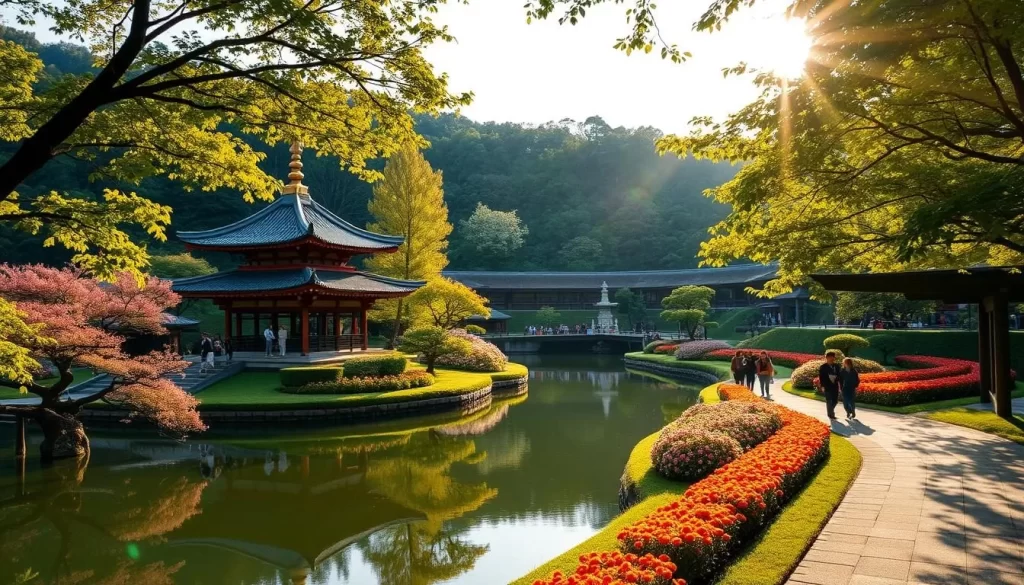
The unique setting of Sengan-en, a 17th-century garden and former residence of the powerful Shimadzu clan, adds to the festival’s charm. The garden offers a view of Sakurajima volcano across Kinko Bay, creating a picturesque backdrop for the chrysanthemum displays.
During the festival period, visitors can enjoy traditional tea ceremonies, cultural performances, and special exhibitions that complement the flower displays. These events enhance the overall experience, making the Sengan-en Chrysanthemum Festival a perfect site for experiencing Japanese autumn traditions.
The festival seamlessly combines natural beauty, traditional aesthetics, and historical significance, making it a must-visit event for anyone interested in Japanese culture. By attending the Sengan-en Chrysanthemum Festival, you can immerse yourself in the rich cultural heritage of Kagoshima Prefecture.
Ogionsa Festival: Prayers for Prosperity
In the heart of Kagoshima, the Ogionsa Festival stands out as an ancient ritual that embodies the community’s prayers for prosperity. This significant event is a testament to the region’s rich cultural heritage and its people’s deep connection with their history.
The Ancient Rituals and Processions
The Ogionsa Festival is an ancient ritual dedicated to prayers for prosperity and protection from disease, representing one of Kagoshima’s oldest continuous traditions. At its core is a central procession that typically moves from the shrine toward the sea, symbolizing the carrying of misfortune away from the community. This symbolic act is a powerful reminder of the community’s dependence on the sea and its bounty.
Participants in the Ogionsa Festival wear distinctive costumes and masks, many of which represent deities or spiritual beings believed to have protective powers. These elaborate costumes are not just visually striking but also carry deep symbolic meaning, reflecting the community’s beliefs and values.
The festival includes various ritual elements that have been preserved for centuries, such as purification ceremonies, offerings, and specialized chants or prayers. These elements are crucial to understanding the festival’s significance and its role in the community’s spiritual life.
The day of the festival is structured around a series of rituals and ceremonies, beginning with morning preparations and prayers, followed by the main procession, and concluding with ceremonies as daylight fades. Throughout the day, the community comes together to celebrate and pray for prosperity.
The Ogionsa Festival’s symbolism is closely tied to Kagoshima’s traditional economic activities, including agriculture and fishing. The festival reflects the community’s dependence on natural bounty and its gratitude for the land’s and sea’s resources.
| Key Elements | Description | Significance |
|---|---|---|
| Central Procession | Moves from the shrine to the sea | Symbolizes carrying misfortune away |
| Costumes and Masks | Represent deities or spiritual beings | Believed to have protective powers |
| Ritual Elements | Purification ceremonies, offerings, chants | Preserved for centuries, crucial to the festival’s significance |
Ogionsa Festival: Prayers for Prosperity
As you explore the Ogionsa Festival, you’ll discover a rich tapestry of community involvement and cultural heritage. This celebration is not just a spectacle; it’s a living tradition that has been passed down through generations.
Community Involvement and Modern Celebrations
The Ogionsa Festival is characterized by its strong community involvement. People from all walks of life come together, with specific roles assigned based on age, gender, and family lineage, fostering a sense of unity and cooperation. Over the years, the festival has adapted to changing times while maintaining its core spiritual purpose.
This adaptation is evident in the incorporation of new elements that keep the festival relevant to contemporary participants. For instance, modern performances and community gatherings have been added to the traditional rituals, making the festival appealing to a wider audience.
Months before the festival, community members engage in behind-the-scenes preparation, crafting things such as costumes, props, and ritual items. This collective effort not only ensures the festival’s success but also strengthens community bonds.
- The festival includes community meals, performances, and gatherings that enhance local bonds.
- Young people play a significant role in carrying on the tradition, ensuring the festival’s continuation.
- Visitors are welcomed into certain aspects of the celebration, allowing them to experience the festival beyond mere observation.
By involving people of all ages and backgrounds, the Ogionsa Festival remains a vibrant and inclusive celebration. As you participate or observe, you’ll appreciate the depth of community spirit and the efforts to preserve cultural heritage.
Practical Tips for Festival Visitors
To make the most of your visit to Kagoshima, it’s essential to be aware of the various festivals that take place throughout the year. Kagoshima Prefecture is known for its rich cultural heritage, and its festivals are a significant part of this identity.
Best Times to Visit Kagoshima for Festivals
Understanding the festival calendar is crucial for planning your trip effectively. Kagoshima hosts a wide range of festivals across different seasons, each offering a unique cultural experience.
The best time to visit Kagoshima for festivals depends on your preferences and what you want to experience. The festivals are spread throughout the year, with some peak periods when multiple events occur in close succession.
- Seasonal Festival Calendar: Kagoshima’s festivals are distributed across spring, summer, autumn, and winter. Spring is a popular time with cherry blossom festivals, while summer is known for its lively dance and fireworks festivals.
- Ideal Visit Times: The ideal time to visit depends on the festival concentration, weather conditions, and tourist crowd levels. For instance, spring and autumn are generally considered good times due to the comfortable weather.
- Lunar Calendar Festivals: Some festivals follow the lunar calendar, which means their dates can vary each year. It’s a good idea to check the most current information before planning your trip.
- Minimum Stay Durations: The duration of your stay should be based on the type of festival experience you’re looking for. Single-day events might require just a short visit, while multi-day celebrations will necessitate a longer stay.
- Festival Combinations: Certain festivals are geographically close, allowing you to experience multiple events during your visit. Planning your itinerary around these combinations can enhance your cultural experience.
- Advance Planning: For popular festivals, it’s advisable to make arrangements months in advance. This includes booking accommodations and making travel plans to ensure a smooth trip.
By considering these factors and planning your trip accordingly, you can have a more fulfilling experience at Kagoshima’s festivals. Whether you’re interested in cultural performances, traditional dances, or spectacular fireworks, there’s something for everyone in Kagoshima.
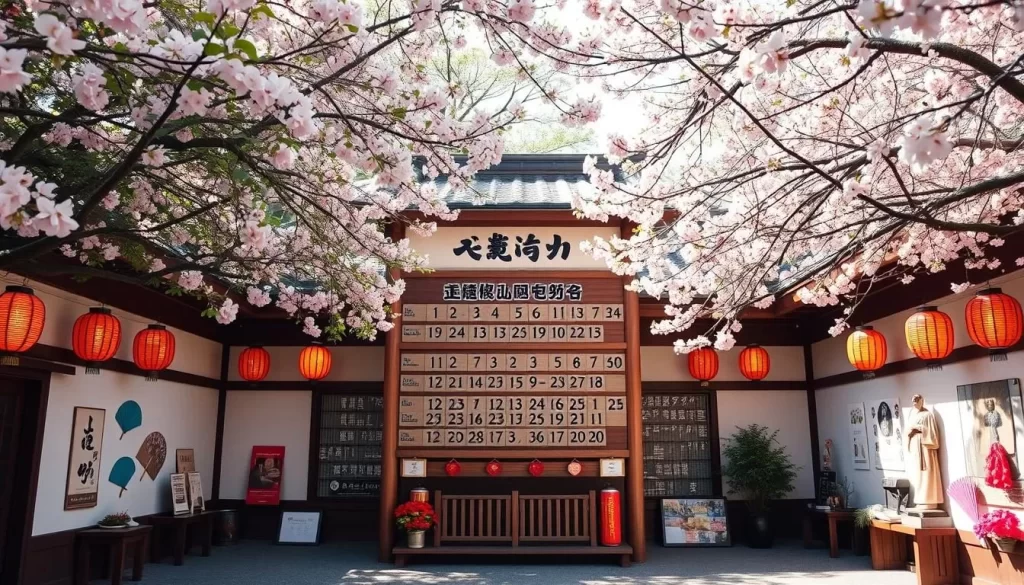
Practical Tips for Festival Visitors
Getting to and staying in Kagoshima during its vibrant festivals requires some planning, but with the right information, you’ll be well-prepared.
Transportation Options
Kagoshima is accessible by various means of transportation. The nearest airport is Kagoshima Airport, which is connected to major cities like Tokyo and Osaka through frequent flights. From the airport, you can take a bus or train to reach the city center.
The JR Kyushu Rail Pass is a cost-effective option for traveling within the region, especially if you plan to visit multiple festival locations. The pass allows you to use JR trains, including the limited express train, which connects Kagoshima to other major cities in Kyushu.
For those who prefer more flexibility, rental cars are available at the airport and major train stations. This option is particularly useful for reaching remote festival locations where public transportation might be limited.
Public Transportation During Major Events
During major festivals, public transportation services are often increased to accommodate the large number of visitors. For instance, additional buses and trains may be operated to and from festival venues, making it easier to get around without a car.
Accommodation Recommendations
Kagoshima offers a range of accommodations to suit different preferences and budgets. Traditional ryokans provide a unique cultural experience, while modern hotels offer comfort and convenience.
For festival visitors, it’s advisable to book accommodations well in advance, as local lodging tends to fill up quickly during major events. Consider staying in hotels or ryokans that are located near festival venues or have easy access to public transportation.
Tips for Booking Accommodations
To avoid last-minute hassles, book your accommodations at least a few weeks in advance. Some popular options include:
- The Kagoshima Plaza Hotel, which is conveniently located near the city center.
- The traditional ryokan, Yachiyo, which offers a unique cultural experience.
- The Hotel Nikko Kagoshima, which provides modern amenities and comfortable rooms.
Navigating Between Festival Locations
To make the most of your festival experience, consider purchasing a regional transportation pass, such as the Kagoshima City Bus One-Day Pass. This pass allows you to hop on and off buses throughout the day, making it easy to visit multiple festival locations.
For remote festival locations, consider using taxi services or ride-sharing options. Some communities also operate shuttle buses during major festivals, so be sure to check the local event information for details.
By planning ahead and using the right transportation and accommodation strategies, you’ll be able to enjoy Kagoshima’s festivals to the fullest.
Practical Tips for Festival Visitors
As you prepare to visit Kagoshima’s vibrant festivals, learning about the cultural considerations will help you navigate the events with confidence. Understanding and respecting local customs can greatly enhance your overall experience.
Cultural Etiquette at Festivals
When attending festivals in Kagoshima, it’s essential to be mindful of the cultural etiquette. This includes being respectful at religious sites and during ceremonial portions of the events. For instance, when visiting shrines or temples, you should dress modestly and avoid loud conversations.
Photography Protocols: Be aware of any photography restrictions or guidelines. Some areas or rituals may prohibit taking pictures, so it’s crucial to be respectful of these rules.
When it comes to dressing for the festivals, consider the type of event and the season. Comfortable footwear is a must, as you’ll likely be standing or walking for extended periods. Dressing according to the season will also ensure that you’re prepared for the weather conditions.
| Festival Type | Recommended Attire | Seasonal Considerations |
|---|---|---|
| Traditional Shinto Festivals | Modest clothing, comfortable shoes | Dress for the season (e.g., light clothing for summer, warm layers for winter) |
| Outdoor Events | Comfortable, practical clothing | Bring sunscreen, hats, or umbrellas as needed |
| Ceremonial Events | Respectful, modest attire | Avoid loud or flashy clothing |
Participating in interactive festival elements can be a fun way to engage with the local culture. However, be sure to follow the lead of the locals and avoid disrupting traditional practices. When dining at festival food stalls, be mindful of dining etiquette, such as handling waste properly and using the typical payment methods.
Learning a few basic Japanese phrases can go a long way in showing respect for the local customs. Phrases like “konnichiwa” (hello), “arigatou” (thank you), and “sumimasen” (excuse me) can enhance your experience and interactions with the locals.
By being aware of and respecting these cultural considerations, you can have a more enjoyable and meaningful experience at Kagoshima’s festivals.
Conclusion: Experiencing the Heart of Kagoshima Through Its Festivals
Kagoshima Prefecture’s festivals are a reflection of the region’s history, spirituality, and community spirit. These vibrant celebrations offer a unique experience that goes beyond the typical tourist attractions, allowing visitors to connect with the authentic traditions of southern Kyushu.
By participating in Kagoshima’s festivals, you’ll gain a deeper understanding of the local culture and create meaningful memories. Whether it’s the Cherry Blossom Festivals in spring, the lively summer dance festivals, or the autumn celebrations, each event provides a distinct perspective on the region’s rich heritage.
The year-round festival calendar in Kagoshima means that there’s always something to look forward to, making it an ideal destination for a trip at any time of the year. As you immerse yourself in these festivals, you’ll not only experience the warmth of the local community but also gain a new appreciation for the cultural practices that have been preserved for generations in southern Kyushu.
As you plan your next adventure, consider making Kagoshima’s festivals a centerpiece of your journey. It’s an opportunity to experience the heart of Kagoshima and discover the cultural treasures that make this region so unique.
The above is subject to change.
Check back often to TRAVEL.COM for the latest travel tips and deals.






